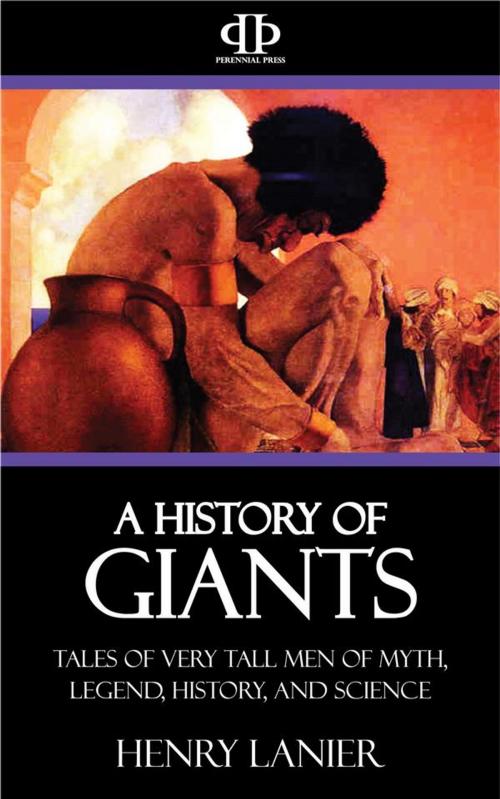| Author: | Henry Lanier | ISBN: | 9781518351198 |
| Publisher: | Perennial Press | Publication: | December 26, 2015 |
| Imprint: | Language: | English |
| Author: | Henry Lanier |
| ISBN: | 9781518351198 |
| Publisher: | Perennial Press |
| Publication: | December 26, 2015 |
| Imprint: | |
| Language: | English |
Man in his youth was so fond of giants that, not finding them large or plentiful enough, he created a bounteous supply. He gave them precedence of himself. In the frozen North they came even before the gods: in the East, after the celestials but before the creation of the world; in Greece they sprang into being just after the Olympians and fiercely disputed the sovereignty of Zeus.
Many ancient gods were vast in size: witness, for instance, the colossal statues of Egypt, China or the South Seas. But the palm for bigness must go to those giant beings whom we find amid Chaos in the East: like that Tiamat from whom the Babylonian god Bel formed heavens and earth; and Purushu of the Hindu Vedas, whose severed head was sufficient for making the sky, his feet for the earth, his eye for the sun, and his mind for the moon.
Somehow, these are too large; nowadays one can hardly digest a giant like that. Even those huge and terrible beings with bodies of stone who once descended upon the Iroquois Indians seem more like Djinn or Rakshasas: they do not fascinate as does that monstrous black warder of the bridge at Mantrible, who was fifteen feet tall with "tuskes like a bore" and head "like a liberde."
The scholars quarrel over the question whether or not the very word originally meant "earth-born"; but be that as it may, the giants exhibited in these pages (collected after wider search than even Mr. Barnum ever prosecuted for such prodigies) are all creatures of earth, at least in part. Their feet are on the earth, even if like Og, King of Bashan, their heads tower high enough to drink straight from the clouds.
They all have a semblance of human beings, as they should. If this seems doubtful remember Ea-Bani. His story is certainly the first to be put on record, for it was baked in clay at least 2500 years ago, the twelve tablets being found among King Assur-bani-pal's library at Nineveh. Ea-bani was a huge giant, who lived with the wild animals, and who defied every attempt to capture him—until King Gilgamesh abandoned force and sent a very beautiful woman to stand quietly near one of the hairy creature's lurking places. At first sight of her the colossal wild man falls in love; accompanies her meekly back to civilization: and, giving up his beloved forest, takes a humble second part in the subsequent stirring adventures of the King. No doubt about the human nature of that!
Man in his youth was so fond of giants that, not finding them large or plentiful enough, he created a bounteous supply. He gave them precedence of himself. In the frozen North they came even before the gods: in the East, after the celestials but before the creation of the world; in Greece they sprang into being just after the Olympians and fiercely disputed the sovereignty of Zeus.
Many ancient gods were vast in size: witness, for instance, the colossal statues of Egypt, China or the South Seas. But the palm for bigness must go to those giant beings whom we find amid Chaos in the East: like that Tiamat from whom the Babylonian god Bel formed heavens and earth; and Purushu of the Hindu Vedas, whose severed head was sufficient for making the sky, his feet for the earth, his eye for the sun, and his mind for the moon.
Somehow, these are too large; nowadays one can hardly digest a giant like that. Even those huge and terrible beings with bodies of stone who once descended upon the Iroquois Indians seem more like Djinn or Rakshasas: they do not fascinate as does that monstrous black warder of the bridge at Mantrible, who was fifteen feet tall with "tuskes like a bore" and head "like a liberde."
The scholars quarrel over the question whether or not the very word originally meant "earth-born"; but be that as it may, the giants exhibited in these pages (collected after wider search than even Mr. Barnum ever prosecuted for such prodigies) are all creatures of earth, at least in part. Their feet are on the earth, even if like Og, King of Bashan, their heads tower high enough to drink straight from the clouds.
They all have a semblance of human beings, as they should. If this seems doubtful remember Ea-Bani. His story is certainly the first to be put on record, for it was baked in clay at least 2500 years ago, the twelve tablets being found among King Assur-bani-pal's library at Nineveh. Ea-bani was a huge giant, who lived with the wild animals, and who defied every attempt to capture him—until King Gilgamesh abandoned force and sent a very beautiful woman to stand quietly near one of the hairy creature's lurking places. At first sight of her the colossal wild man falls in love; accompanies her meekly back to civilization: and, giving up his beloved forest, takes a humble second part in the subsequent stirring adventures of the King. No doubt about the human nature of that!















